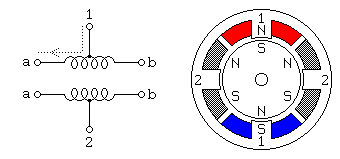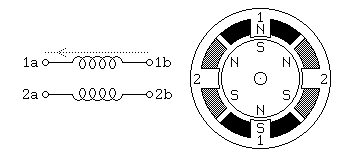Stepper Motor Theory
A stepper motor is a permanent magnet or variable reluctance dc motor that has the following performance characteristics:
- rotation in both directions,
- precision angular incremental changes,
- repetition of accurate motion or velocity profiles,
- a holding torque at zero speed, and
- capability for digital control.
A stepper motor can move in accurate angular increments knows as steps in response to the application of digital pulses to an electric drive circuit from a digital controller. The number and rate of the pulses control the position and speed of the motor shaft. Generally, stepper motors are manufactured with steps per revolution of 12, 24, 72, 144, 180, and 200, resulting in shaft increments of 30, 15, 5, 2.5, 2, and 1.8 degrees per step.
Stepper motors are either bipolar, requiring two power sources or a switchable polarity power source, or unipolar, requiring only one power source. They are powered by dc current sources and require digital circuitry to produce the coil energizing sequences for rotation of the motor. Feedback is not always required for control, but the use of an encoder or other position sensor can ensure accuracy when it is essential. The advantage of operating without feedback is that a closed loop control system is not required. Generally, stepper motors produce less than 1 horsepower(746W) and are therefore frequently used in low-power position control applications.
Unipolar stepper motor

Unipolar stepping motors with 5 or 6 wires are usually wired as shown in the schematic in Figure 1, with a center tap on each of two windings. In use, the center taps of the windings are typically wired to the positive supply, and the two ends of each winding are alternately grounded to reverse the direction of the field provided by that winding. The motor cross section shown in Figure 1 is of a 30 degree per step motor -- the difference between these two motor types is not relevant at this level of abstraction. Motor winding number 1 is distributed between the top and bottom stator pole, while motor winding number 2 is distributed between the left and right motor poles. The rotor is a permanent magnet with 6 poles, 3 south and 3 north, arranged around its circumfrence. For higher angular resolutions, the rotor must have proportionally more poles. The 30 degree per step motor in the figure is one of the most common permanent magnet motor designs, although 15 and 7.5 degree per step motors are widely available. As shown in the figure, the current flowing from the center tap of winding 1 to terminal a causes the top stator pole to be a north pole while the bottom stator pole is a south pole. This attracts the rotor into the position shown. If the power to winding 1 is removed and winding 2 is energised, the rotor will turn 30 degrees, or one step. To rotate the motor continuously, we just apply power to the two windings in sequence. Assuming positive logic, where a 1 means turning on the current through a motor winding, the following two control sequences will spin the motor illustrated in Figure 1 clockwise 24 steps or 4 revolutions:
Winding 1a 1000100010001000100010001 Winding 1b 0010001000100010001000100 Winding 2a 0100010001000100010001000 Winding 2b 0001000100010001000100010 time ---> Winding 1a 1100110011001100110011001 Winding 1b 0011001100110011001100110 Winding 2a 0110011001100110011001100 Winding 2b 1001100110011001100110011 time --->
Note that the two halves of each winding are never energized at the same time. Both sequences shown above will rotate a permanent magnet one step at a time. The top sequence only powers one winding at a time, as illustrated in the figure above; thus, it uses less power. The bottom sequence involves powering two windings at a time and generally produces a torque about 1.4 times greater than the top sequence while using twice as much power.
Bipolar stepper motor
Bipolar permanent magnet and hybrid motors are constructed with exactly the same mechanism as is used on unipolar motors, but the two windings are wired more simply, with no center taps. Thus, the motor itself is simpler but the drive circuitry needed to reverse the polarity of each pair of motor poles is more complex. The schematic in Figure 2 shows how such a motor is wired. while the motor cross section shown here is exactly the same as the cross section shown in Figure 1. The drive circuitry for such a motor requires an H-bridge control circuit for each winding. Briefly, an H-bridge allows the polarity of the power applied to each end of each winding to be controlled independently. The control sequences for single stepping such a motor are shown below, using + and - symbols to indicate the polarity of the power applied to each motor terminal:
Terminal 1a +---+---+---+--- Terminal 1b --+---+---+---+- Terminal 2a -+---+---+---+-- Terminal 2b ---+---+---+---+ time --->
Note that these sequences are identical to those for a unipolar permanent magnet motor, at an abstract level, and that avove the level of the H-bridge power switching electronics, the control systems for the two types of motor can be identical. Note that many full H-bridge driver chips have one control input to enable the output and another to control the direction. Given such bridge chips, one for eachwinding, the following control sequences will spin the motor identically to the control sequences given above:
Enable 1 1111111111111111 Direction 1 1100110011001100 Enable 2 1111111111111111 Direction 2 0110011001100110 time --->
To distinguish a bipolar permanent magnet motor from other 4 wire motors, measure the resistances between the different terminals. It is worth noting that some permanent magnet stepping motors have 4 independent windings, organized as two sets of two. Within each set, if the two windings are wired in series, the result can be used as a high voltage bipolar motor. If they are wired in parallel, the result can be used as a low voltage bipolar motor. If they are wired in series with a center tap, the result can be used as a low voltage unipolar motor.
References
- Jones, Douglas W., "Control of Stepping Motors: A Tutorial", http://www.cs.uiowa.edu/~jones/step/
- Wikipedia, "Stepper Motor", http://en.wikipedia.org/wiki/Stepper_motor
